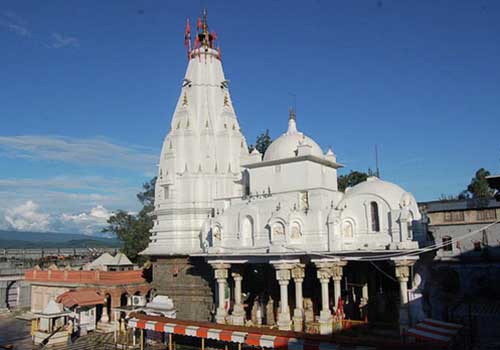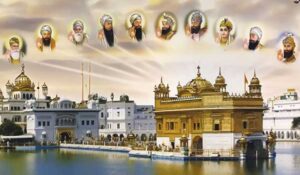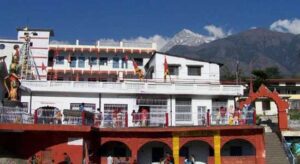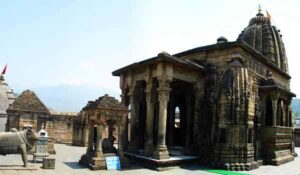Maa Vajreshwari (Brajeshwari)Devi Temple is a Hindu temple dedicated to the goddess Vajreshvari, located in the town Nagarkot, in the Kangra district of Himachal Pradesh, India. Vajreshwari Devi Temple is 11 km away from the nearest railway station of Kangra. The Kangra Fort is situated nearby. It is located on a mountain near Chamunda Devi temple which is 16 km from Nagarkot.
The primary deity of the temple is Maata Vajreshvari, also spelled as Brajeshwari, Vajrábái and Vajrayogini. Maata Vajreshvari is considered as an incarnation of goddess Parvati or Aadi-Maya on earth. Her name literally means “the lady of the Vajra (thunderbolt)”.  Legend says that thousands of years ago, a Rakshasa (demon) named Kalikala or Kalikut troubled the rishis (sages) and humans in the region of Vadvali and waged a war against the devas (gods). Distressed the gods and sages headed by Vashishta performed the Chandi yajna, a fire offering to the Goddess, to please Her. An aahuti (offering of ghee in yajna) was not granted to Indra (king of devas). Enraged, Indra hurled his Vajra – one of most powerful weapons in Hindu mythology- at the yajna. The terrified gods and sages prayed to the Goddess to save them. The Goddess appeared in all her glory at the site and not only swallowed the Vajra and humbled Indra but also killed the demons. Rama requested the Goddess that she should stay in the region of Nagarkot and be known as Vajreshvari. Thus, the Vajreshvari temple was established in this region.
Legend says that thousands of years ago, a Rakshasa (demon) named Kalikala or Kalikut troubled the rishis (sages) and humans in the region of Vadvali and waged a war against the devas (gods). Distressed the gods and sages headed by Vashishta performed the Chandi yajna, a fire offering to the Goddess, to please Her. An aahuti (offering of ghee in yajna) was not granted to Indra (king of devas). Enraged, Indra hurled his Vajra – one of most powerful weapons in Hindu mythology- at the yajna. The terrified gods and sages prayed to the Goddess to save them. The Goddess appeared in all her glory at the site and not only swallowed the Vajra and humbled Indra but also killed the demons. Rama requested the Goddess that she should stay in the region of Nagarkot and be known as Vajreshvari. Thus, the Vajreshvari temple was established in this region.
Another legend says that Indra and other devas went to goddess Parvati and requested her to help slay the demon Kalikala. Goddess Parvati assured that she would come to their aid at the right time and ordered them to fight with the demon. In the battle, Kalikala swallowed or broke all weapons thrown at him. Finally, Indra threw the Vajra at the demon, which Kalikala broke into pieces and from the Vajra, emerged the Goddess, who destroyed the demon. The devas extolled her as Vajreshwari and built her temple.
Another legend says that after Goddess Sati sacrificed herself in the honor of Lord Shiva in her Fathers Yagya. Shiva took her body on his shoulder and started Tandav. In order to stop him from destroying the world Lord Vishnu divided the body of Sati into 52 parts with his Chakra. The left breast of Sati fell at this spot, thus making it a Shakti Peeth.
The original temple was built by the Pandavas at the time of Mahabharatha. Legend says that one day Pandavas saw Goddess Durga in their dream in which she told them that she is situated in the Nagarkot village and if they want them self to be secure they should make a temple for her in that area otherwise they will be destroyed. That same night they made a magnificent temple for her in the Nagarkot village. This temple was looted a number of time by the Muslim invaders. Md Gaznavi looted this temple at least 5 times, in the past it used to contain tonnes of gold and many ghantas made of pure silver. In 1905 the temple was destroyed by a powerful earthquake and was subsequently rebuilt by the government.
The main gate entrance has a Nagarkhana or drum house and is built similar to the Bassein fort entrance. The temple is also surrounded by a stone wall like a fort. Inside the main area Goddess Vajreshvari is present in the form of Pindi. The temple also have a small temple of Bhairav. In front of the main temple an idol of Dhayanu Bhagat is also present. He had offered his head to the Goddess at the time of Akbar. The present structure has three tombs in it, which is unique in itself.
The temple celebrates Navaratri once from the first day of fortnight of waxing moon of the Hindu month of Chaitra (March) to the ninth day of Ram Navami and then from the first day of the bright half of the Hindu month of Ashvin (October) to the 10th day Vijayadashami.
A huge fair in honour of Goddess Vajreshwari is held on Amavasya (new moon day) in the month of Chaitra. The fair commences on the 14th day of fortnight of waning moon of the month with ceremonial worship of the Goddess. On Amavasya at night, lamps are worshipped. On the next day, the first day of Hindu month Vaisakha, the ceremonial procession with a Palkhi (palanquin) carrying an image of the goddess, is taken out. Other festivals the temple celebrates are Shiva worship in Hindu month of Shravana; Kojagiri Poornima – full moon day of Hindu month Ashvin; Diwali (festival of lights); Holi (festival of colours); Datta Jayanti (birthday of the deity Datta); Hanuman Jayanti (birthday of monkey god Hanuman) and Godhadebuwa Jayanti (birthday of the saint Godhadebuwa).
Makar sakrantri, which comes on second week of January, is also celebrated in the temple. Legend says that after killing Mahishasura in the battle, devi had got some injuries. to heel those injuries Goddess had applied Makhan (butter) on her body, in Nagarkot. Thus to mark this day the Pindi of Goddess is covered with Makhan and the festival is celebrated for a week in the temple.


